An Examination of Expenditures and Costs in Small Business Firms
VerifiedAdded on 2023/06/03
|5
|1122
|386
Homework Assignment
AI Summary
This assignment analyzes the expenditures of small business firms, particularly in the context of the information technology and online grocery delivery sectors. The first part examines the cost structure of information goods and services, highlighting the dominance of large firms and their impact on pricing. It discusses how these firms leverage financial strength and economies of scale to influence market costs. The second part focuses on the challenges faced by small online grocery businesses, including narrow consumer bases, high operational costs, and competition from larger e-commerce companies like Amazon. It also explores how factors like transaction costs and network externalities affect firm size, advertising, and pricing. The analysis points out how lowering expenditures, particularly those related to e-commerce platforms and payment gateways, can help small firms compete. The assignment emphasizes the importance of understanding market dynamics and cost structures for small businesses to achieve and maintain a competitive advantage.
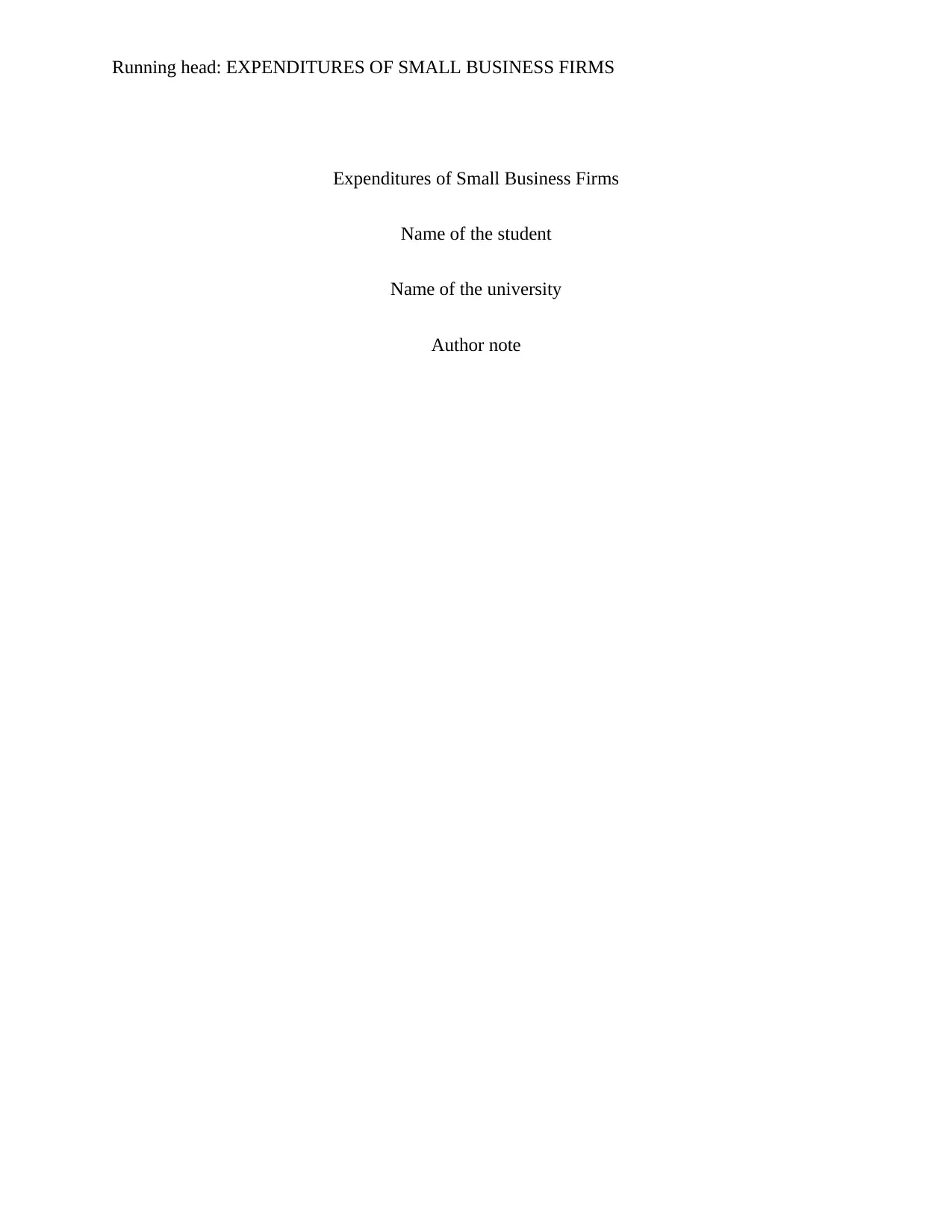
Running head: EXPENDITURES OF SMALL BUSINESS FIRMS
Expenditures of Small Business Firms
Name of the student
Name of the university
Author note
Expenditures of Small Business Firms
Name of the student
Name of the university
Author note
Paraphrase This Document
Need a fresh take? Get an instant paraphrase of this document with our AI Paraphraser
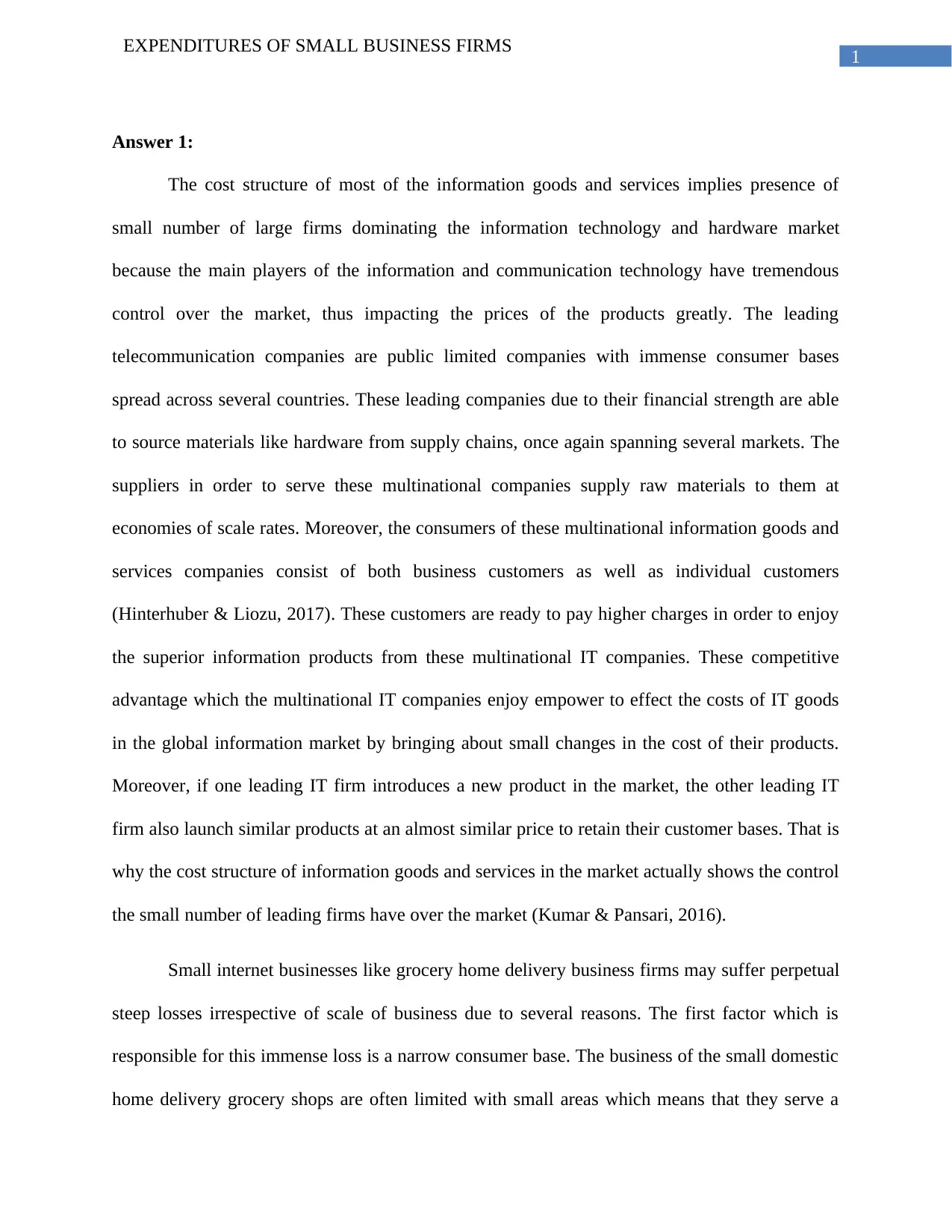
1
EXPENDITURES OF SMALL BUSINESS FIRMS
Answer 1:
The cost structure of most of the information goods and services implies presence of
small number of large firms dominating the information technology and hardware market
because the main players of the information and communication technology have tremendous
control over the market, thus impacting the prices of the products greatly. The leading
telecommunication companies are public limited companies with immense consumer bases
spread across several countries. These leading companies due to their financial strength are able
to source materials like hardware from supply chains, once again spanning several markets. The
suppliers in order to serve these multinational companies supply raw materials to them at
economies of scale rates. Moreover, the consumers of these multinational information goods and
services companies consist of both business customers as well as individual customers
(Hinterhuber & Liozu, 2017). These customers are ready to pay higher charges in order to enjoy
the superior information products from these multinational IT companies. These competitive
advantage which the multinational IT companies enjoy empower to effect the costs of IT goods
in the global information market by bringing about small changes in the cost of their products.
Moreover, if one leading IT firm introduces a new product in the market, the other leading IT
firm also launch similar products at an almost similar price to retain their customer bases. That is
why the cost structure of information goods and services in the market actually shows the control
the small number of leading firms have over the market (Kumar & Pansari, 2016).
Small internet businesses like grocery home delivery business firms may suffer perpetual
steep losses irrespective of scale of business due to several reasons. The first factor which is
responsible for this immense loss is a narrow consumer base. The business of the small domestic
home delivery grocery shops are often limited with small areas which means that they serve a
EXPENDITURES OF SMALL BUSINESS FIRMS
Answer 1:
The cost structure of most of the information goods and services implies presence of
small number of large firms dominating the information technology and hardware market
because the main players of the information and communication technology have tremendous
control over the market, thus impacting the prices of the products greatly. The leading
telecommunication companies are public limited companies with immense consumer bases
spread across several countries. These leading companies due to their financial strength are able
to source materials like hardware from supply chains, once again spanning several markets. The
suppliers in order to serve these multinational companies supply raw materials to them at
economies of scale rates. Moreover, the consumers of these multinational information goods and
services companies consist of both business customers as well as individual customers
(Hinterhuber & Liozu, 2017). These customers are ready to pay higher charges in order to enjoy
the superior information products from these multinational IT companies. These competitive
advantage which the multinational IT companies enjoy empower to effect the costs of IT goods
in the global information market by bringing about small changes in the cost of their products.
Moreover, if one leading IT firm introduces a new product in the market, the other leading IT
firm also launch similar products at an almost similar price to retain their customer bases. That is
why the cost structure of information goods and services in the market actually shows the control
the small number of leading firms have over the market (Kumar & Pansari, 2016).
Small internet businesses like grocery home delivery business firms may suffer perpetual
steep losses irrespective of scale of business due to several reasons. The first factor which is
responsible for this immense loss is a narrow consumer base. The business of the small domestic
home delivery grocery shops are often limited with small areas which means that they serve a
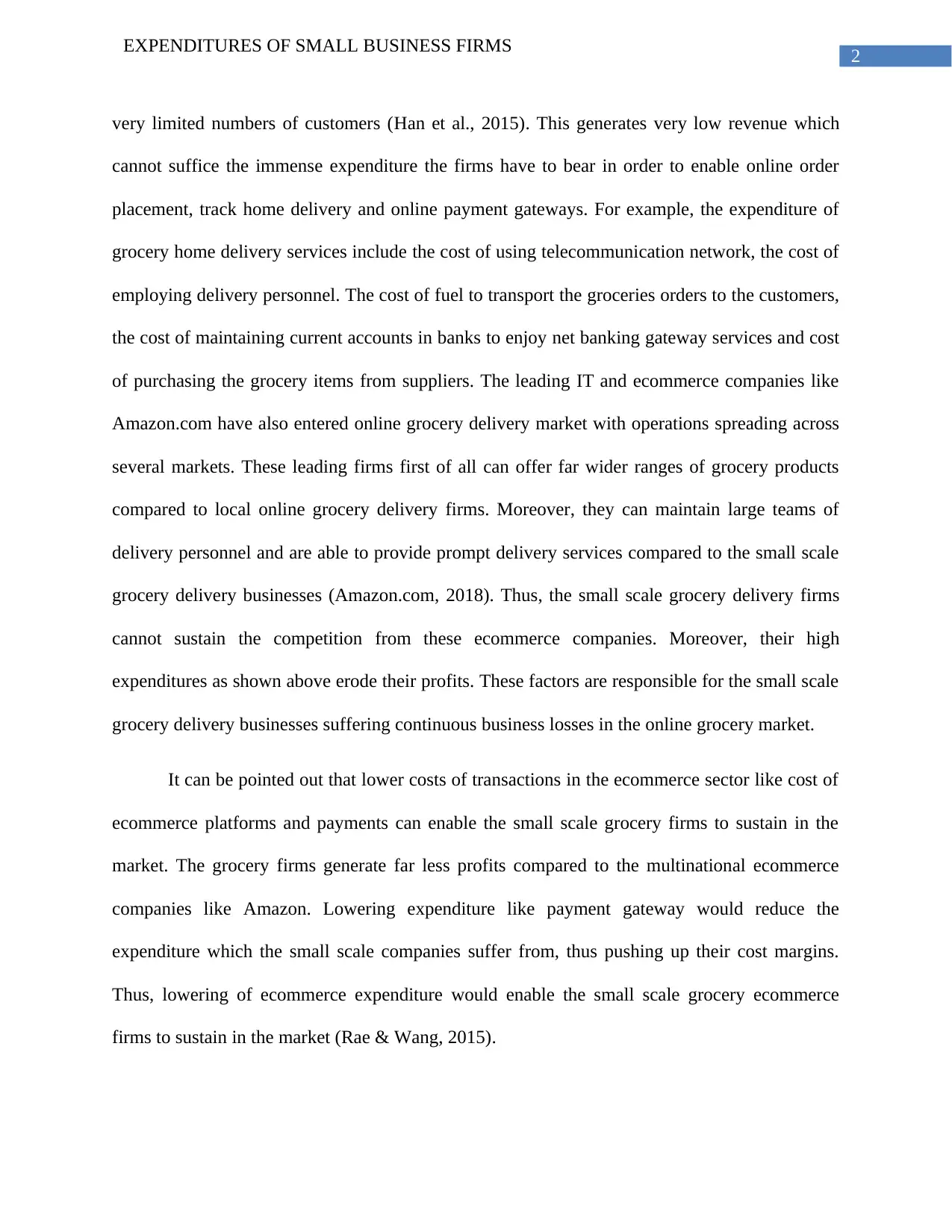
2
EXPENDITURES OF SMALL BUSINESS FIRMS
very limited numbers of customers (Han et al., 2015). This generates very low revenue which
cannot suffice the immense expenditure the firms have to bear in order to enable online order
placement, track home delivery and online payment gateways. For example, the expenditure of
grocery home delivery services include the cost of using telecommunication network, the cost of
employing delivery personnel. The cost of fuel to transport the groceries orders to the customers,
the cost of maintaining current accounts in banks to enjoy net banking gateway services and cost
of purchasing the grocery items from suppliers. The leading IT and ecommerce companies like
Amazon.com have also entered online grocery delivery market with operations spreading across
several markets. These leading firms first of all can offer far wider ranges of grocery products
compared to local online grocery delivery firms. Moreover, they can maintain large teams of
delivery personnel and are able to provide prompt delivery services compared to the small scale
grocery delivery businesses (Amazon.com, 2018). Thus, the small scale grocery delivery firms
cannot sustain the competition from these ecommerce companies. Moreover, their high
expenditures as shown above erode their profits. These factors are responsible for the small scale
grocery delivery businesses suffering continuous business losses in the online grocery market.
It can be pointed out that lower costs of transactions in the ecommerce sector like cost of
ecommerce platforms and payments can enable the small scale grocery firms to sustain in the
market. The grocery firms generate far less profits compared to the multinational ecommerce
companies like Amazon. Lowering expenditure like payment gateway would reduce the
expenditure which the small scale companies suffer from, thus pushing up their cost margins.
Thus, lowering of ecommerce expenditure would enable the small scale grocery ecommerce
firms to sustain in the market (Rae & Wang, 2015).
EXPENDITURES OF SMALL BUSINESS FIRMS
very limited numbers of customers (Han et al., 2015). This generates very low revenue which
cannot suffice the immense expenditure the firms have to bear in order to enable online order
placement, track home delivery and online payment gateways. For example, the expenditure of
grocery home delivery services include the cost of using telecommunication network, the cost of
employing delivery personnel. The cost of fuel to transport the groceries orders to the customers,
the cost of maintaining current accounts in banks to enjoy net banking gateway services and cost
of purchasing the grocery items from suppliers. The leading IT and ecommerce companies like
Amazon.com have also entered online grocery delivery market with operations spreading across
several markets. These leading firms first of all can offer far wider ranges of grocery products
compared to local online grocery delivery firms. Moreover, they can maintain large teams of
delivery personnel and are able to provide prompt delivery services compared to the small scale
grocery delivery businesses (Amazon.com, 2018). Thus, the small scale grocery delivery firms
cannot sustain the competition from these ecommerce companies. Moreover, their high
expenditures as shown above erode their profits. These factors are responsible for the small scale
grocery delivery businesses suffering continuous business losses in the online grocery market.
It can be pointed out that lower costs of transactions in the ecommerce sector like cost of
ecommerce platforms and payments can enable the small scale grocery firms to sustain in the
market. The grocery firms generate far less profits compared to the multinational ecommerce
companies like Amazon. Lowering expenditure like payment gateway would reduce the
expenditure which the small scale companies suffer from, thus pushing up their cost margins.
Thus, lowering of ecommerce expenditure would enable the small scale grocery ecommerce
firms to sustain in the market (Rae & Wang, 2015).
⊘ This is a preview!⊘
Do you want full access?
Subscribe today to unlock all pages.

Trusted by 1+ million students worldwide
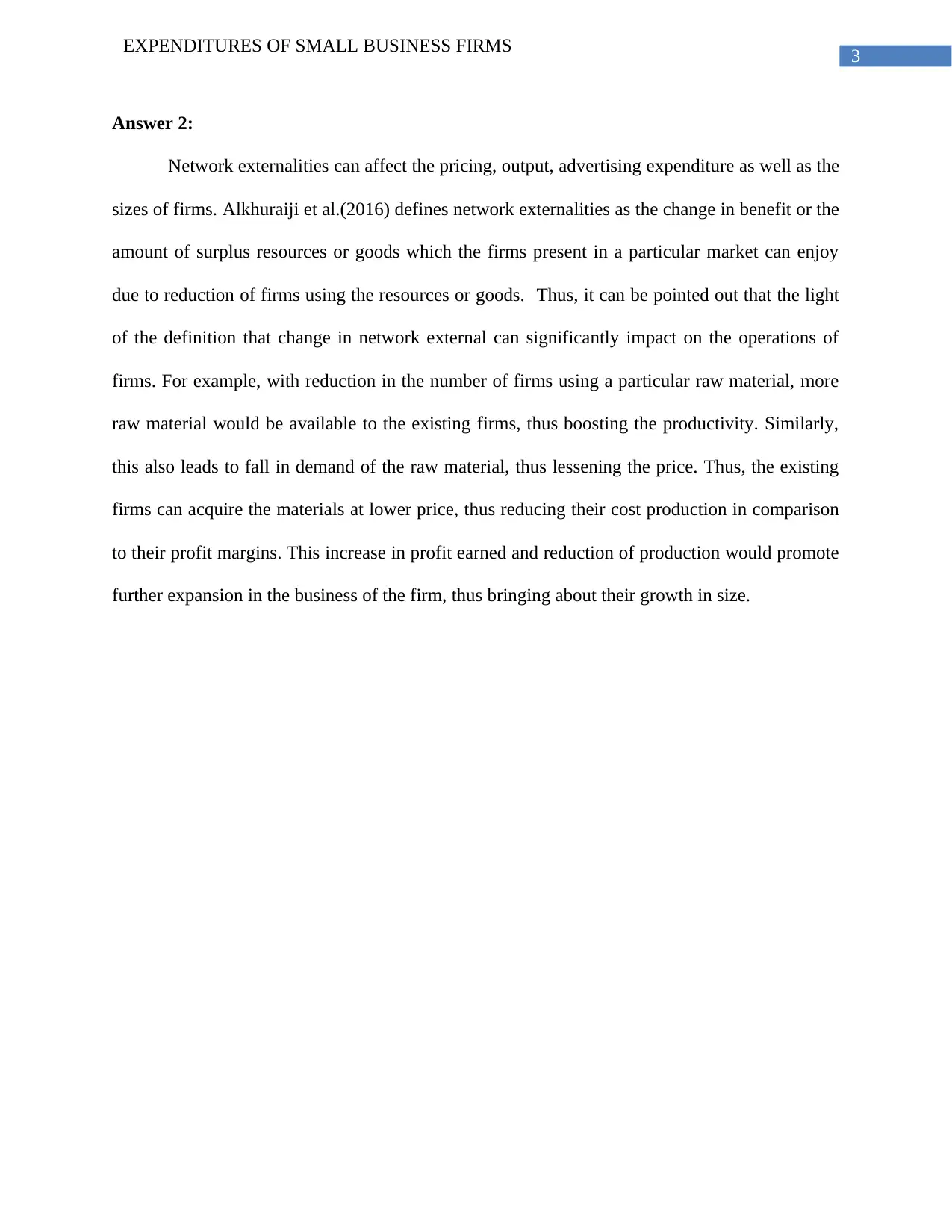
3
EXPENDITURES OF SMALL BUSINESS FIRMS
Answer 2:
Network externalities can affect the pricing, output, advertising expenditure as well as the
sizes of firms. Alkhuraiji et al.(2016) defines network externalities as the change in benefit or the
amount of surplus resources or goods which the firms present in a particular market can enjoy
due to reduction of firms using the resources or goods. Thus, it can be pointed out that the light
of the definition that change in network external can significantly impact on the operations of
firms. For example, with reduction in the number of firms using a particular raw material, more
raw material would be available to the existing firms, thus boosting the productivity. Similarly,
this also leads to fall in demand of the raw material, thus lessening the price. Thus, the existing
firms can acquire the materials at lower price, thus reducing their cost production in comparison
to their profit margins. This increase in profit earned and reduction of production would promote
further expansion in the business of the firm, thus bringing about their growth in size.
EXPENDITURES OF SMALL BUSINESS FIRMS
Answer 2:
Network externalities can affect the pricing, output, advertising expenditure as well as the
sizes of firms. Alkhuraiji et al.(2016) defines network externalities as the change in benefit or the
amount of surplus resources or goods which the firms present in a particular market can enjoy
due to reduction of firms using the resources or goods. Thus, it can be pointed out that the light
of the definition that change in network external can significantly impact on the operations of
firms. For example, with reduction in the number of firms using a particular raw material, more
raw material would be available to the existing firms, thus boosting the productivity. Similarly,
this also leads to fall in demand of the raw material, thus lessening the price. Thus, the existing
firms can acquire the materials at lower price, thus reducing their cost production in comparison
to their profit margins. This increase in profit earned and reduction of production would promote
further expansion in the business of the firm, thus bringing about their growth in size.
Paraphrase This Document
Need a fresh take? Get an instant paraphrase of this document with our AI Paraphraser
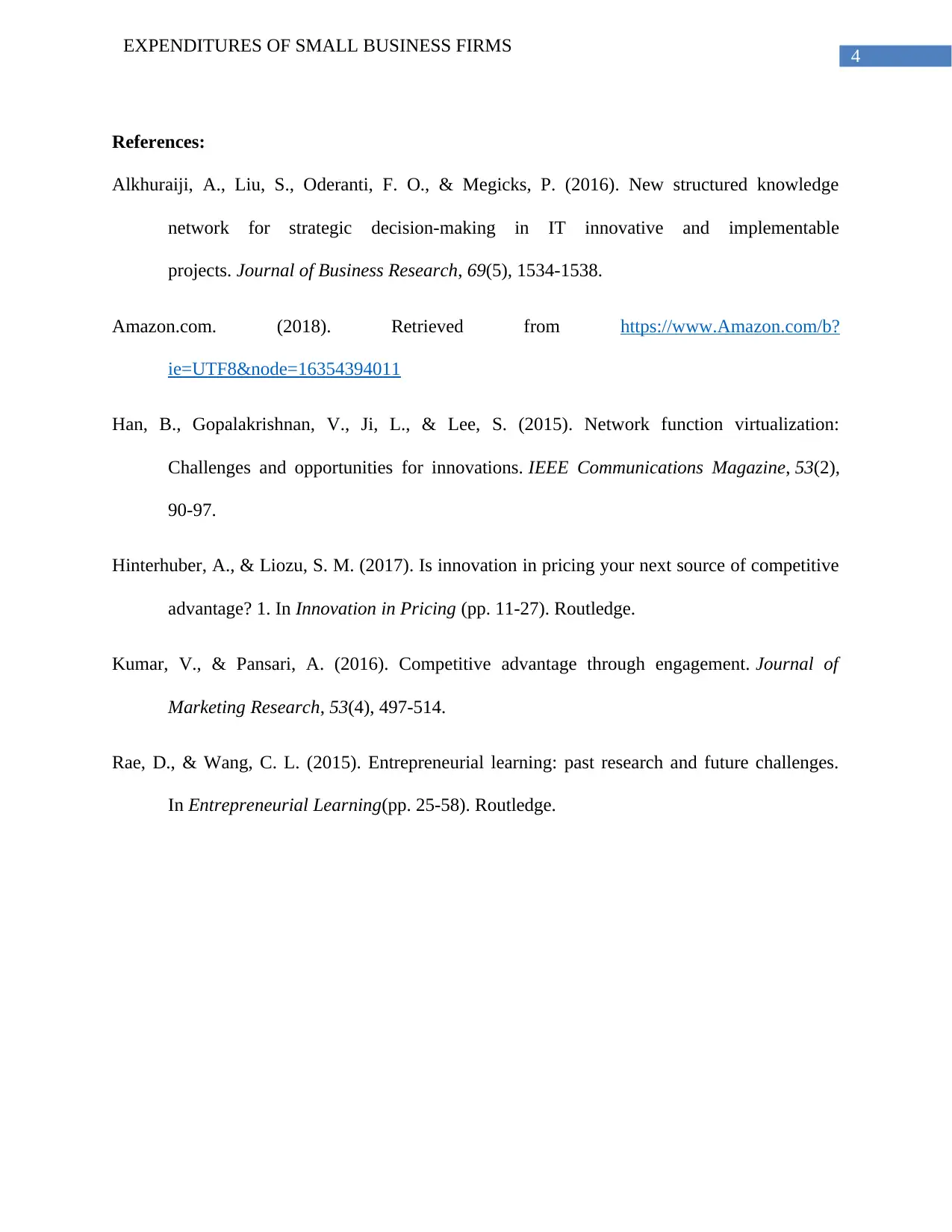
4
EXPENDITURES OF SMALL BUSINESS FIRMS
References:
Alkhuraiji, A., Liu, S., Oderanti, F. O., & Megicks, P. (2016). New structured knowledge
network for strategic decision-making in IT innovative and implementable
projects. Journal of Business Research, 69(5), 1534-1538.
Amazon.com. (2018). Retrieved from https://www.Amazon.com/b?
ie=UTF8&node=16354394011
Han, B., Gopalakrishnan, V., Ji, L., & Lee, S. (2015). Network function virtualization:
Challenges and opportunities for innovations. IEEE Communications Magazine, 53(2),
90-97.
Hinterhuber, A., & Liozu, S. M. (2017). Is innovation in pricing your next source of competitive
advantage? 1. In Innovation in Pricing (pp. 11-27). Routledge.
Kumar, V., & Pansari, A. (2016). Competitive advantage through engagement. Journal of
Marketing Research, 53(4), 497-514.
Rae, D., & Wang, C. L. (2015). Entrepreneurial learning: past research and future challenges.
In Entrepreneurial Learning(pp. 25-58). Routledge.
EXPENDITURES OF SMALL BUSINESS FIRMS
References:
Alkhuraiji, A., Liu, S., Oderanti, F. O., & Megicks, P. (2016). New structured knowledge
network for strategic decision-making in IT innovative and implementable
projects. Journal of Business Research, 69(5), 1534-1538.
Amazon.com. (2018). Retrieved from https://www.Amazon.com/b?
ie=UTF8&node=16354394011
Han, B., Gopalakrishnan, V., Ji, L., & Lee, S. (2015). Network function virtualization:
Challenges and opportunities for innovations. IEEE Communications Magazine, 53(2),
90-97.
Hinterhuber, A., & Liozu, S. M. (2017). Is innovation in pricing your next source of competitive
advantage? 1. In Innovation in Pricing (pp. 11-27). Routledge.
Kumar, V., & Pansari, A. (2016). Competitive advantage through engagement. Journal of
Marketing Research, 53(4), 497-514.
Rae, D., & Wang, C. L. (2015). Entrepreneurial learning: past research and future challenges.
In Entrepreneurial Learning(pp. 25-58). Routledge.
1 out of 5
Related Documents
Your All-in-One AI-Powered Toolkit for Academic Success.
+13062052269
info@desklib.com
Available 24*7 on WhatsApp / Email
![[object Object]](/_next/static/media/star-bottom.7253800d.svg)
Unlock your academic potential
Copyright © 2020–2025 A2Z Services. All Rights Reserved. Developed and managed by ZUCOL.




